Frozen custard
Frozen custard is a cold dessert similar to ice cream, but made with eggs in addition to cream and sugar.[1] It is usually kept at a warmer temperature compared to ice cream, and typically has a denser consistency.
 Chocolate flavored frozen custard | |
| Type | Custard |
|---|---|
| Main ingredients | eggs, cream, sugar |
History
Egg yolks have been integrated into ice creams since at least the 1690s,[2] though there are several notable invention stories that are associated with modern commercializations of this practice.
One early commercialization of frozen custard was in Coney Island, New York in 1919, when ice cream vendors Archie and Elton Kohr found that adding egg yolks to ice cream created a smoother texture and helped the ice cream stay cold longer. In their first weekend on the boardwalk, they sold 18,460 cones.[3]
A frozen custard stand at the 1933 World's Fair in Chicago introduced the dessert to a wider audience.[4] Following the fair, the dessert's popularity spread throughout the Midwest; Milwaukee, Wisconsin, in particular, became known as the "unofficial frozen custard capital of the world".[5][6][7]
Per capita, Milwaukee has the highest concentration of frozen custard shops in the world[8] and the city supports a long-standing three-way competition between Kopp's Frozen Custard, Gilles Frozen Custard and Leon's Frozen Custard.
Major frozen custard chains in the United States include Culver's, headquartered in Prairie du Sac, Wisconsin, with outlets in 20 states; Freddy's Frozen Custard & Steakburgers, based in Wichita, Kansas, with more than 300 locations nationwide; and Andy's Frozen Custard, based in Springfield, Missouri, with over 70 locations in 13 states.[9] Other chains serving frozen custard include Ted Drewes, Rita's, The Meadows, and Abbott's.
Characteristics
In the U.S., the Food and Drug Administration requires products marketed as frozen custard to contain at least 10 percent milkfat and 1.4 percent egg yolk solids. If it has a smaller percentage of egg yolk solids, it is considered ice cream.[10]
True frozen custard is a very dense dessert. Soft serve ice creams may have an overrun as large as 100%, meaning half of the final product is composed of air. Frozen custard, when made in a continuous freezer will have an overrun of 15–30% depending on the machine manufacturer (an overrun percentage similar to gelato). Air is not pumped into the mix, nor is it added as an "ingredient" but gets into the frozen state by the agitation of liquid similar to whisking a meringue. The high percentage of butterfat and egg yolk gives frozen custard a thick, creamy texture and a smoother consistency than ice cream. Frozen custard can be served at −8 °C (18 °F), warmer than the −12 °C (10 °F) at which ice cream is served, in order to make a soft serve product.
Another difference between commercially produced frozen custard and commercial ice cream is the way the custard is frozen. The mix enters a refrigerated tube and, as it freezes, blades scrape the product cream off the barrel walls. The now frozen custard is discharged directly into containers from which it can be served. The speed with which the product leaves the barrel minimizes the amount of air in the product but more importantly ensures that the ice crystals formed are very small.
See also
- Custard, the basic egg and dairy preparations
- Frozen yogurt, the cultured and frozen milk product
- Gelato, the Italian style of ice cream
- Ice cream
- List of custard desserts
- List of frozen custard companies
- Semifreddo, the partially frozen type of desserts, sometimes a custard mixed with whipped cream
- Soft serve, a soft form of ice cream
References
- Brienza, Laura (2015). Discovering Vintage Washington, DC: A Guide to the City's Timeless Shops. Jai Williams (photographer). Guilford, Conn.: Globe Pequot. p. 63. ISBN 9781493013418. Retrieved June 27, 2019.
- McGee, Harold (2004). On Food and Cooking. New York: Scribner. p. 39. ISBN 978-0-684-80001-1.
- Robert Sietsema (June 14, 2005). "Happy Days". The Village Voice.
- Peter Genovese. "Kohr's". The Jersey Shore Uncovered. pp. 57–60.
- "The History of Frozen Custard". Ollie's Frozen Custard. Archived from the original on October 17, 2016.
- "Custard-ology 101". Just Indulge. Archived from the original on September 24, 2012.
- "What is Frozen Custard?".
- "Andy's has frozen custard! Great! So, what is it?". Archived from the original on April 20, 2009.
- "All Locations". Andy's Frozen Custard | Ice Cream. Retrieved 2019-03-26.
- "FDA Frozen Desserts 21 CFR 135.110(a)(2)". FDA. Retrieved 17 July 2010.